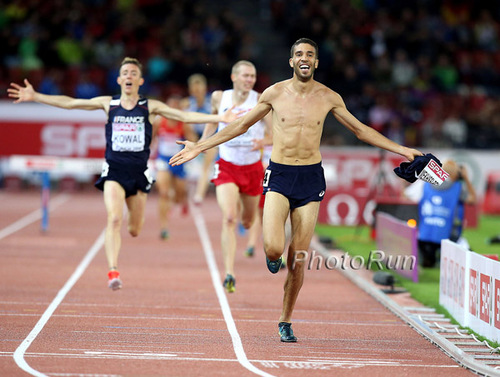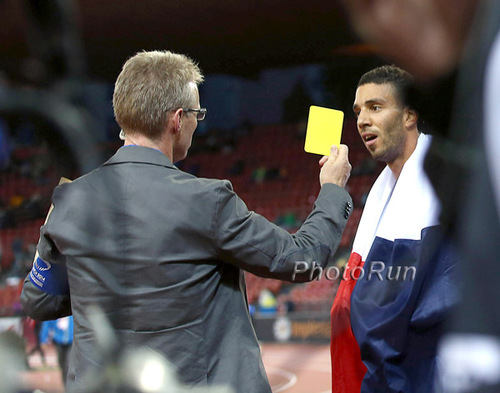So, how could I not ask Cathal Dennehy to write up the year in Athletics, A-Z? Cathal writes for our partner, Jumping the Gun.com . I like part one of his list, A-M. What do you think?
RelatedPosts
A DQ for Mekhissi-Benabbad, photo by PhotoRun.net
A is for the Anti-hero: Mekhissi-Benabbad
To tell any good story, you need one. Every book, every film, and even every sport, needs the villain who fans either love to hate or just can’t help but love. This year, Frenchman Mahiedine Mekhissi-Benabbad took that role. Previously, the steeplechase specialist was best known for picking fights with a mascot and his countryman Mehdi Baala, but this year he became even more infamous. Leading the 3,000m steeplechase final by a street at the Europeans in August, Mekhissi-Benabbad tore off his singlet and ran the last 100m topless. Justified celebration? Needless arrogance? Opinion was divided, but either way, he was disqualified. When asked, after later in the week taking the 1500m title, about criticism of his celebration, he said: “people who make such noises do not understand sport. They come just to eat chips.”
B is for Berlin: where records go to die
On a perfectly cool, calm and sunny day in September, it happened yet again. On the pancake-flat streets of the German Capital, yet another unfathomably fluent, incomprehensibly skinny East African lowered the world record in the race that has virtually monopolised the all-time list in the men’s marathon. This time it was 30-year-old Dennis Kimetto, who with his time of 2:02:57 became the sixth man in just 11 years to lower the all-time best on the streets of Berlin.
C is for Continental Cup: an event without an audience
Going to Marrakech, Morocco for the Continental Cup was a risky move for the IAAF. Sure, it expanded the event into a new territory, albeit one with an already proud athletics tradition, but as it turned out, the locals didn’t care all that much to come see the world’s best athletes strut their stuff at the end of the track season. The races were played out in front of mostly empty stands, and with a couple of minor exceptions on day two, the event was run in a hushed, virtually non-existent atmosphere.
D is for Doping: the cancer of the sport
Where do you start? It was a year when the long-held suspicions about doping being rife in Russian athletics truly came to the surface, due in large part to the work of investigative journalist Hajo Seppelt of ARD. It was also a year where suspicions of a growing doping problem in Kenya gained more than just traction, but snowballed into cold, hard evidence as prolific marathon champion Rita Jeptoo tested positive for EPO, a story first broken on RunBlogRun. Then there was the curious case of Liliya Shobukhova, the Russian who appeared to initially succeed in her attempts to pay her way out of a positive test, but then had her case made public. It was all one big mess for the sport, but if it accomplished one thing, it is that it established a sort of low-tide moment which can allow athletics to now move on, while also serving as a reminder to dopers that no matter how remote their residence, how sophisticated their approach, they can be caught. In anti-doping, a strong deterrent is probably the most powerful weapon.
E is for Eugene: a good year for Tracktown USA
In July, the spotlight shone on Eugene, a sleepy University town in Oregon, for the IAAF World Junior Championships and by all means, it rose to the occasion. The event was attended by a substantial crowd, who didn’t just know their athletics; they loved it. Mary Cain’s win in the women’s 3,000m set off a deafening roar among the Hayward Field stands, which have witnessed many an historic moment in the sport. Later in the year, Eugene came up short in its bid for the 2019 World Championships, but it shouldn’t be discouraged by its runner-up status. They will come again. If there’s a cooler place to watch athletics than Hayward Field, then I haven’t seen it.
F is for Four years: doping bans now doubled
As of the 1st of January 2015, the IAAF has the power to apply a four-year doping ban for a first offence under the new WADA code. What’s that sound you hear? That’s clean athletes around the world rejoicing at what many have felt was a long-overdue initiative. The noose again tightens around the dopers’ necks, the deterrent that much stronger. Let’s face it, this won’t magically conjure up a clean sport all of a sudden, but it’s a damn good place to start, and one giant leap in the quest to defeat the cheats.
G is for Gatlin: track and field’s not-so-lovable rogue
In the absence of Usain Bolt for much of the year, it was Justin Gatlin – who has previously sat out a four-year doping ban – who was the undisputed sprint king. The American, who ran personal bests of 9.77 for 100m and 19.68 for 200m this year at the age of 32, was utterly dominant on the track, and if he can bring that form into the 2015 season, Bolt will have a hell of a fight on his hands on his return to the Bird’s Nest Stadium in Beijing for the World Championships. Many fans, though, may understandably be withholding their applause for him.
H is for Harting: discus giant takes a stand
Many fans had voiced their displeasure at having Gatlin back and cleaning up at events on the circuit this year, but one of the first athletes to take a stand publicly against Gatlin was German discus thrower Robert Harting. The Olympic champion asked the IAAF to remove him from their shortlist for the World Athlete of the Year Award due to Gatlin’s inclusion. It was a bold move from the German and one that is likely to pressure the IAAF to change their selection criteria for future editions of the award.
I is for Incroyable: the race, the comeback of the year
With 150m to go, it was seemingly settled – the women’s 4x400m relay at the European Championships in Zurich. Maybe not the specific arrangement of the medals, but certainly the top three teams: Ukraine, Russia and Great Britain. France, with anchor runner Floria Guei, was a good 10 metres behind, at least, as they rounded the home turn. Then, something incredible happened. The leading trio began to fade, and meanwhile Guei was rocketing home, and she somehow got to the front about a millimetre before they crossed the line. It was simply inconceivable just 10 seconds before, but somehow, it happened. It was sport at its very finest. Incroyable. Don’t believe me? Just watch: https://www.youtube.com/watch?v=G-VYwC28KXI
J is for Jo: supermum Pavey outkicks Father Time
A lot of incredible things happened at those European Championships in Zurich, not least a 40-year-old mother of two, who just a few months earlier thought that scraping onto the British team would be the height of her season’s ambition, taking an unforgettable gold in the 10,000m. Pavey had returned from the birth of her daughter in late 2013 and as late as April this year, was still struggling for any kind of form. Somehow, though, it clicked for her in the summer, as she took bronze over 5,000m at the Commonwealth Games and then gold in Zurich.
K is for the King: Farah still holds the throne
Yes, his marathon experiment in April ended in the kind of befuddled confusion and ultimate disappointment that afflicts a distracted young chemistry student, but once he left the marathon behind and returned to the track in the summer, Mo Farah showed that he is still the man when it comes to middle distance races on the track. He took the 5,000m and 10,000m double at the European Championships in August, then went on to take a narrow victory in the Great North Run. His marathon ambitions shelves, possibly forever, his focus will remain on the track until Rio 2016. It’s what he knows best, what he does best, and in that kingdom, he is still the king.
L is for Lavillenie: hitting ever-greater heights
At one point, Sergey Bubka’s pole vault world record of 6.15m looked unbreakable, but finally this year, in Bubka’s home town of Donetsk, Renaud Lavillenie sailed over 6.16m to establish an all-time best. Lavillenie then went on to win both the European Championships and the Continental Cup, and won 21 of his 22 competitions in 2014, which earned him a much-deserved IAAF World Athlete of the Year Award.
M is for Monaco: the doyen of Diamond Leagues
It’s always hard to say which is the best of the meets on the Diamond League circuit. Zurich is the traditionalist’s pick, Brussels has the finale and a huge crowd, while Oslo has its own intimate charm. However, in 2014 at least, the meet of the year was Monaco. It’s where athletes have gravitated more and more in search of fast times, and that was the case again this year as Justin Gatlin blazed to a 19.68-second 200m, five men ran 1:42 in the 800m, Silas Kiplagat ran 3:27 in the 1500m, and Ajee Wilson edged Eunice Sum in a thrilling 800m, with both athletes running 1:57. Everywhere you looked, there was another great race, another great time. It won’t always have it this perfect, but in 2014, Monaco stood alone in its magnificence.
Author

Larry Eder has had a 52-year involvement in the sport of athletics. Larry has experienced the sport as an athlete, coach, magazine publisher, and now, journalist and blogger. His first article, on Don Bowden, America's first sub-4 minute miler, was published in RW in 1983. Larry has published several magazines on athletics, from American Athletics to the U.S. version of Spikes magazine. He currently manages the content and marketing development of the RunningNetwork, The Shoe Addicts, and RunBlogRun. Of RunBlogRun, his daily pilgrimage with the sport, Larry says: "I have to admit, I love traveling to far away meets, writing about the sport I love, and the athletes I respect, for my readers at runblogrun.com, the most of anything I have ever done, except, maybe running itself." Also does some updates for BBC Sports at key events, which he truly enjoys. Theme song: Greg Allman, " I'm no Angel."
View all posts






















